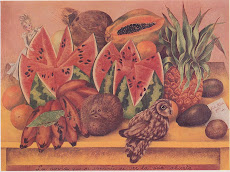Dear Ian et al.,
Many thanks for the invitation. What follows takes seriously the luxury of the blog format whereby big topics can be mused on and written in short periods of time! In your really informative and enjoyable paper you ask: “Have important perspectives been underplayed, misunderstood, ignored?” (p.10). When considering the various geographies of food, I think it is important to consider the role of aesthetics.
It seems to me that the social practices and experiences of preparing and eating food bring to the fore aesthetic spaces qua the taking place of sensory values and judgments of taste. I believe that aesthetics, so often eclipsed by or mistakenly opposed to ‘the political’, is one of the most undervalued categories in critical geographies of food. Too often in critical human geography, our engagements with aesthetic events and spaces involve an impatient appeal to their more ‘serious’ socio-economic and political imports and ramifications. I think it is important that we are able to find ways to critically map the aesthetical taking place as both part of and separate from the social and the political (Kingsbury, 2005; forthcoming). On the question of the ethics of interpreting Otherness, Tim Dean (2002, 38) writes the following:
Although cultural studies (especially in its postcolonialist variants) has elaborated an ethical commitment to honoring the alterity of other cultures and their subjects—that is, a commitment to respecting the various ways in which different cultural ontologies might not make sense within the terms of hegemonic discourse—there has been less willingness to extend this ethical commitment to the aesthetic realm as such…While we try to respect the otherness of other persons, our interpretive practices do not respect the otherness of art. It is as if art needed to come from an alien culture before we could concede that some aspect of it remains untranslatable into meaning (p.38).
I don’t think it is too far a stretch to replace the word “art” with “food” in the above. I think there is a great deal of alluring Otherness that permeates the social spaces of food cultures: for example, the strange taste of a certain ingredient; the elusive X-factor that makes a certain food exquisite or repellant; the odd way someone prepares a specific dish; the difficulty of putting into words the wonderful or dreadful taste of a food item. The aesthetics of what you call the “rich and complex connections” (p.9) in Simon Choo’s example seems especially relevant here. Perhaps these allures and enigmas of food (that pertain to the senses, especially taste and smell) are one of the reasons why food is a key vehicle for defining, bonding, and mediating people’s experiences of cultural Otherness (see also Žižek, 1993, 200-237). Take for example the policies and practices of multiculturalism. And here I write from the perspective of living in Vancouver, BC, Canada. During the past decade or so in Canada, the state, corporations, and settlement agencies have increasingly invested in multicultural events including festivals and parades to promote local ethno-cultural heritage, diversity, and unity through the consumption of food. While these events are structured around the aesthetics of celebration, enjoyment, and revelry, as we know they are also fraught with political struggles over appropriate cultural practices, identities, and beliefs.
I believe that much of multiculturalism and its political dimensions are not entirely “beyond, food, festival, folklore, and fashion” (Meyer and Rhoades, 2006), but also intimately related to such domains insofar as they incarnate the aesthetics of food. I agree with geographers, for example, yourself (Cook and Harrison, 2003) and Claire Dwyer and Phil Crang (2002) that the commodification (of food) is not a thing that is submitted or done to pre-existing ethnicities and ethnic subjects but a process through which ethnicities are reproduced. I would argue that much of this process of reproducing and defining ethnicities and cultures is intimately related to aesthetics qua the enduring alluring mysteries of food.
Well, I hope the above is suitably ‘bloggy’. It’s sketchy for sure and that’s why I’d like to devote some of my future research on the intersections between the aesthetics, politics, and multicultural consumption.
Best wishes,
Paul Kingsbury
Department of Geography,
Simon Fraser University,
Canada
References
Cook, I. and Harrison, M. 2003. Cross over food: re-materializing postcolonial geographies. Transactions of the Institute of British Geographers 28 (3), 296-317.
Dwyer, C. and Crang, P. 2002. Fashioning Ethnicities: The Commercial Spaces of Multiculture. Ethnicities 2 (3), 410-430.
Dean, T. 2002. Art as symptom: Žižek and the ethics of psychoanalytic criticism. Diacritics 32 (2), 21-41.
Kingsbury, P. Jamaican tourism and the politics of enjoyment. Geoforum 36 (1), 113-132.
Kingsbury, P. Forthcoming. Unearthing Nietzsche’s Bomb: Explosiveness, Nuance, Aesthetics. ACME: An International E-Journal for Critical Geographies.
Meyer, C.F. and Rhoades, E.K. 2006. Multiculturalism: Beyond food, festival, folklore, and fashion. Childhood Education 42 (2), 82-87.
Žižek, S. 1993. Tarrying with the Negative: Kant, Hegel, and the Critique of Ideology. Duke University Press: Durham, NC.
Wednesday, August 27, 2008
Subscribe to:
Post Comments (Atom)

No comments:
Post a Comment